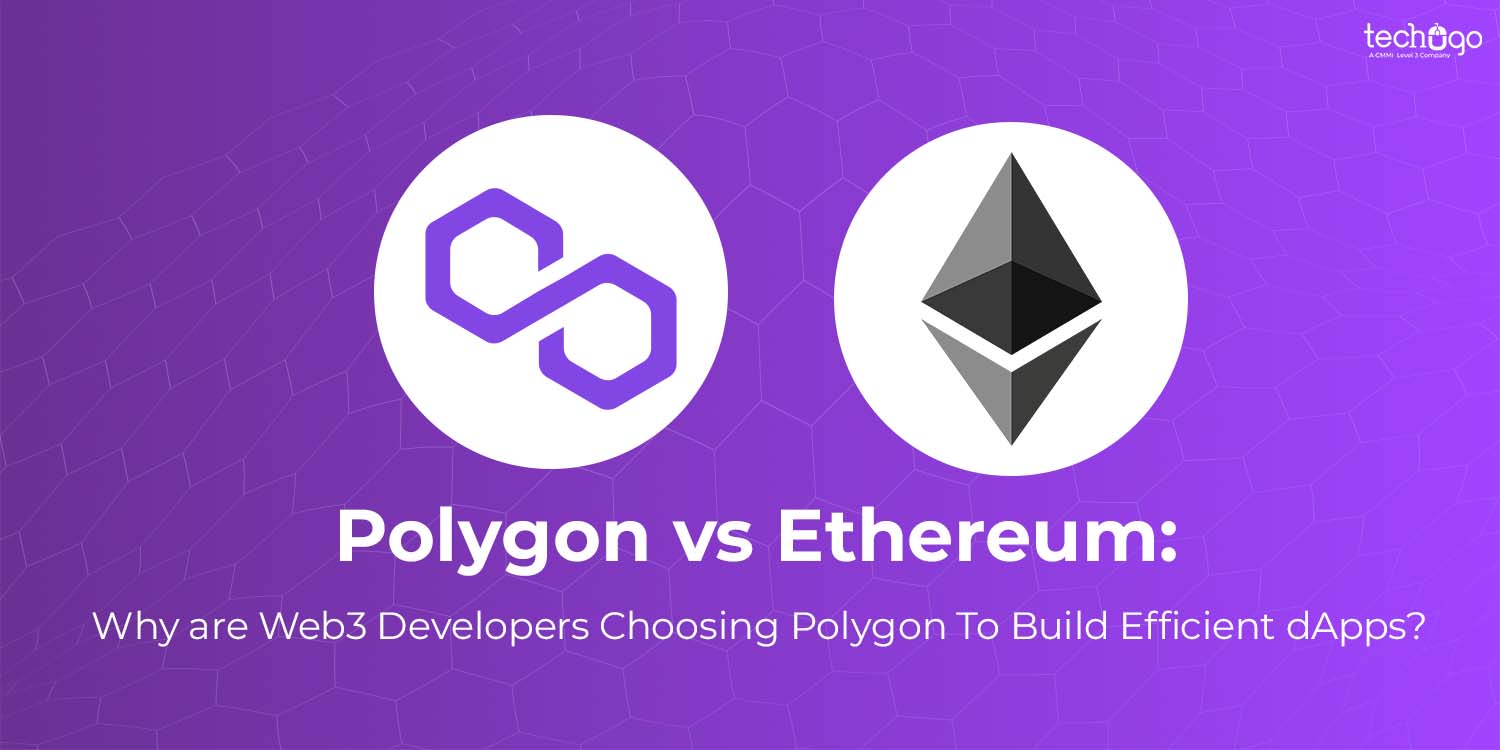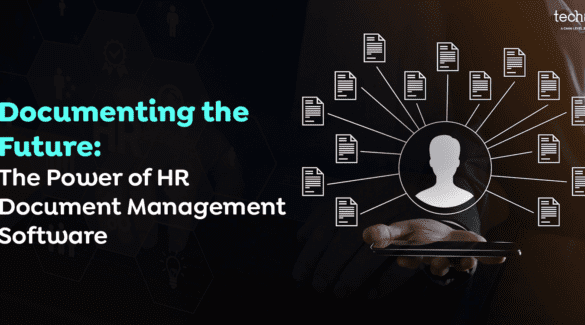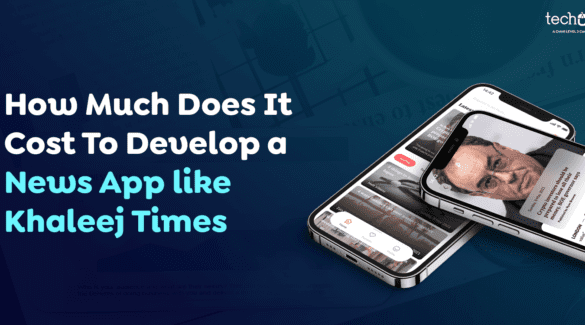22 Mar 2023
Polygon vs Ethereum: Why are Web3 Developers Choosing Polygon To Build Efficient dApps?
Namrata

Polygon offers many options for developers when creating dApps on Polygon. While some developers prioritize speed over security, others compromise protection to lower fees. The technology is creating multiple Ethereum-centric scaling options to address these various features.
Ethereum has been a strong pillar of the cryptocurrency market. From DeFi to intelligent contracts to NFTs, Ethereum is a crucial innovation of Web3.0. However, despite its apparent success, Ethereum has been plagued by network congestion, high transaction fees, and low transaction throughput. These factors have allowed for the development of newer crypto projects. One such project is Polygon.
Polygon has 53,000 dApps. Businesses are now using the technology’s low costs and speed to develop Ethereum-powered apps.
This article will discuss many aspects of Polygon, and which one is better for dApps development: Polygon vs Ethereum.
Introduction to Polygon
Polygon is a decentralized scaling tool specifically designed for the Ethereum network. It allows developers to connect Ethereum-compatible intelligent contracts within the Polygon platform and create scalable apps with meager transaction fees.
Polygon was introduced to the world in 2021 as Matic Network. It was then rebranded as Polygon, an internet of Ethereum blockchains based on Proof of Stake (PoS). Polygon is Ethereum’s Layer 2 solution. It can be interoperable with Ethereum’s infrastructure. Polygon addresses the main problems of Ethereum, namely slow transactions and high gas fees.
How does Polygon work? It works just like any other PoS-based cryptocurrency. It has its infrastructure, token, validator nodes, and native apps. The only difference is that transactions are settled on the Ethereum main chain.
Polygon is the next big thing in crypto ecosystems
The Rise of Polygon
Polygon was one of the top gainers for 2021. In January 2021, the price of Polygon rose from $0.01 to $2.92 by December 2021. Polygon has gained attention in the crypto community over the past year for other reasons.
Polygon, in partnership with Seven Six from Alexis Ohanian’, launched a $200 million initiative to support social media and Web3.0 intersectoral projects. Additionally, the top mobile app development company has plans to launch an NFT marketplace on Polygon.
The number of apps developed on Polygon has increased tremendously from just 30 to 3,000 in a year.
Polygon has worked on cryptos such as Polygon Studios and DeFi DAO DApps, Web3, and the NFT arm through their development team.
The Polygon network also collaborated with governments to develop projects that use blockchain scale-up for COVID-19 data. As a result, Polygon’s scaling solutions have been used by over 400 applications, resulting in approximately 790,000.
Key Database Requirements in dApps for Off-chain Data
Modern dApps teams require the off-chain index accelerator, primary chain, sidechain, and off-chain data to be interoperable. In addition, this architectural pattern makes it crucial for the off-chain data to provide fine-grained security and an ecosystem-friendly query interface.
Data Security – Fine-grained
DApps should ensure high data security and reliability and not expose private data to all databases and chains. ABAC (attribute-based Access Control) in databases can allow dApp teams to feel confident that they can safely store sensitive user information, such as wallet addresses, alongside all other application data.
Ecosystem-friendly query interface
Many apps that use Ethereum leverage The Graph and similar solutions to query on-chain data using GraphQL. GraphQL is a clear description of your API’s data, which makes it easier for developers and users to query different sources (off-chain or on-chain) with the same query language.
Multi-variable Indexing
dApps need to be able to query the system to find the exact data they require for them to remain efficient. Complex off-chain data structures can be complicated due to audibility and anonymity requirements. Compound or composite indexing can transform multiple values from the underlying data and reduce the impact of data complexity and query performance, particularly on latency.
Now let’s see which is beneficial in Polygon vs Ethereum in creating dApps.
Polygon vs Ethereum: Creating dApps
The Merge changed Ethereum’s proof-of-work to proof-of-stake, reducing its 112 TWh energy consumption to 0.01TWh. However, Polygon is still there.
However, the Merge didn’t reduce the variable transaction cost of Ethereum. This is something that Polygon addresses in a significant way. The transaction processing speed of Polygon dApps development has remained at 65,000 transactions per minute due to the Layer 2 scaling solution.
Although Polygon is gaining popularity, some things could still be improved with the technology. Therefore, it is essential to understand the limitations of a Polygon before you can fully appreciate it. So let’s take a look at these limitations:
- Ethereum Dependency: Ethereum is the settlement layer at the heart of Polygon’s ecosystem. Polygon is now utterly dependent upon Ethereum to run its operations.
- Polygon currently has Matic POS Chains (and Matic Plasma) as scaling solutions. There are other scaling options, such as Optimistic Rollups and Zk Rollups, Sidechains, Validum Chains, and Enterprise Chains.They are still in the development stages, and it is still being determined when they will be open to the public.
- Matic Plasma Chains: Only a few use cases can be made with polygon plasma chains. On the other hand, POS Chains are much more popular than Matic Plasma because they offer more flexibility and user experience.
- Competition: There are many scaling options, such as Solana and Cosmos, or Polkadot. These solutions are steadily gaining momentum. To provide a better user experience, they are using Ethereum and other blockchains. We might also see other solutions emerging and taking Polygon’s market share.
Despite all the information we’ve covered, it is clear that Polygon can be used to develop apps.
What platform should you use for your DeFi project?
We have already stated that Ethereum and Polygon are not direct competitors. However, there are some essential differences that you need to consider when choosing between the two.
The main differences between Polygon and Ethereum are transaction speed, cost, and other factors. Poor user experience and expensive gas fees can lead to slow transactions, harming the platform’s adoption. This is why Polygon is recommended, as it offers fast transactions and low gas costs.
Ethereum is the best choice if security is your priority. This blockchain is still popular and has one of the largest communities in the crypto markets.
We recommend you to look again at the differences between the blockchains and compare them with your project goals to make the best decision. You can also seek the assistance of Blockchain developers or consultants with extensive experience working with both platforms. They can offer valuable insight based on your business goals.
Polygon Projects
Regarding Polygon-based projects, a blockchain is an excellent tool for business development. Its key advantage is its ability to scale, which is crucial for many dApps. In addition, the Polygon network has a higher computation power and seamless compatibility with Ethereum. This is an essential factor to consider.
Thanks to its many advantages, this blockchain solution connects payment systems, DEX, and AMM at a lower cost. AAVE, Curve, and QuickSwap are some of the most notable projects that utilize the Polygon ecosystem to operate.
The blockchain network is expected to have a significant advantage over Ethereum in the DeFi and NFT markets.
It would help if you considered many types of Polygon-based projects:
- dApps and file storage services
- Decentralized protocols
- Trading platforms and prediction markets, DEX solutions, and many others
Conclusion
Even though Polygon dApps is built on Ethereum, there are significant differences, particularly in terms of transaction speed and cost. These high gas fees and slow transactions could lead to poor user experiences that can negatively impact the platform’s adoption. It is, therefore, more business-friendly to choose Polygon because it can back faster transactions with lower gas fees.
Techugo is committed to putting our customers first. This is why we have dApps on Polygon. In addition, we have created various decentralized apps using the technology, from a cryptocurrency wallet app to an exchange that offers DeFi. All promise a positive customer experience.
Are you interested in exploring the technology for your next dApp? If yes,then get in touch with Techugo, the blockchain app development company.
Get in touch.
Write Us
sales@techugo.comOr fill this form















